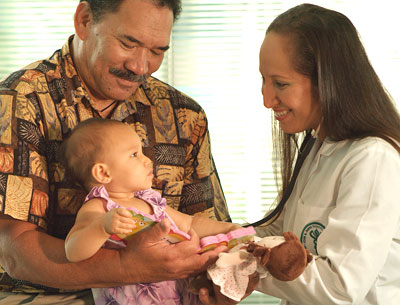
Citing the need to develop programs to address urgent health problems and issues such as obesity, infectious diseases and improving international health, the University of Hawaiʻi at Mānoa announced plans this week to create a School of Global and Community Health.
The school will build on and expand the work of the former School of Public Health, which was closed in 1999 for fiscal reasons. At the time of the school’s closing, university officials expressed the intention to explore reestablishment of a public health school at an appropriate time in the future.
“We recognize a need to increase health sciences education leading to careers in fields such as medicine, nursing, public health, social work and cancer research,” said UH Mānoa Chancellor Virginia Hinshaw. “At the same time, we must also be economically prudent, so we are committed to maximum cooperation among UH Mānoa health-related programs and partnerships with other government and community entities.”
The master of public health program was retained when the School of Public Health closed and merged into the John A. Burns School of Medicine to become a program of what is now the Office of Public Health Studies. The educational programs overseen by the Office of Public Health Studies received a full, seven-year national accreditation in 2007, and the office and its associated programs have grown rapidly.
“The John A. Burns School of Medicine has been a great incubator in growing our Office of Public Health Studies in the last decade,” said Office of Public Health Studies Director Jay Maddock. “In 2000, the public health graduate program at Mānoa had seven students. In 2012, the program now has over 100 students.”
The role of public health education
“The medical school understands that the promotion of health is best achieved in an inter-disciplinary fashion,” said John A. Burns School of Medicine Dean Jerris Hedges. “The roles of physician and public health officer complement one another, yet are quite different. Both fields are currently challenged by an aging workforce, which is aggravating shortages among service providers. These combined shortages will compromise the overall health of the public.”
Maddock explained that unlike some of the other health professionals, public health officers do not typically treat patients or see them in a clinical setting.
“Public health’s focus is on populations, not individuals,” said Maddock. “We train people in healthcare administration and develop solutions to health problems at the community and international level.”
According to Maddock, more than 3,500 graduates of the former UH Mānoa School of Public Health work in the Hawaiʻi State Department of Health and in community health centers throughout Hawaiʻi, the Pacific and Asia.
Timeline and process
The process of establishing the new school will probably require one to three years. It will involve creating a sustainable business plan, recruiting additional faculty and developing academic degree programs in order to qualify for accreditation. The new school’s dean will report to the Mānoa vice chancellor for academic affairs.
“We are committed to a transparent, open process,” said Hinshaw. “There is much we need to discuss with potential partners within the university system, with faculty, staff and students, and with government and community leaders.”
Maddock also believes there is an opportunity to explore a variety of strategies. “We plan to maximize existing resources, share administrative resources with the medical school, minimize new costs and attract funding, which Hawaiʻi will only be eligible to receive if it develops a school of public health.”
–This story was adapted from a UH Mānoa Chancellor’s Office news release

